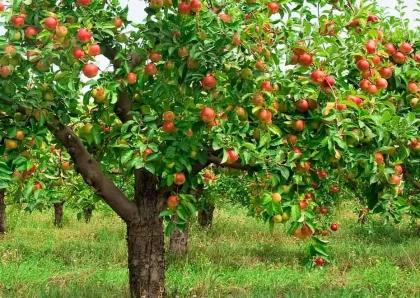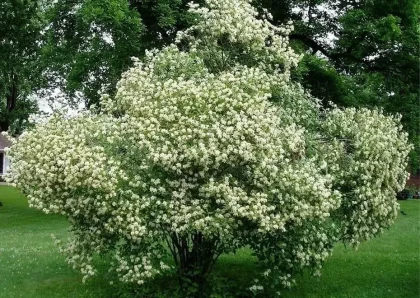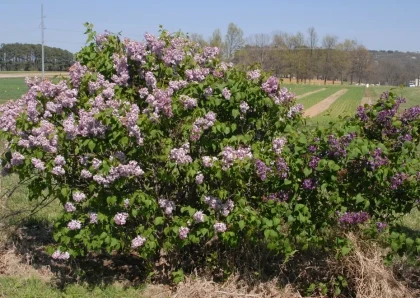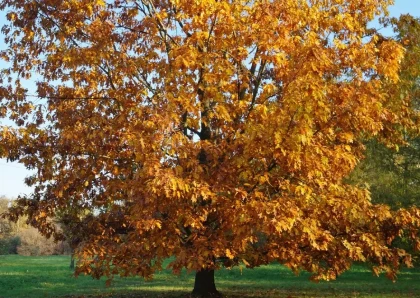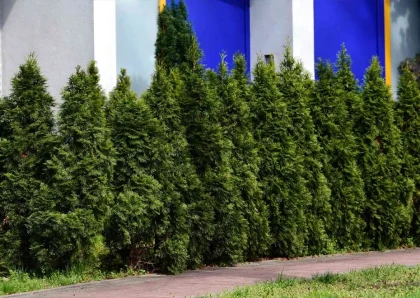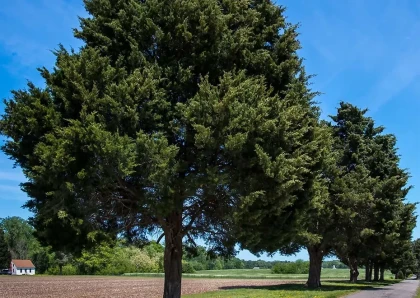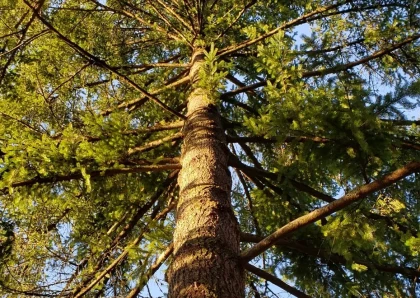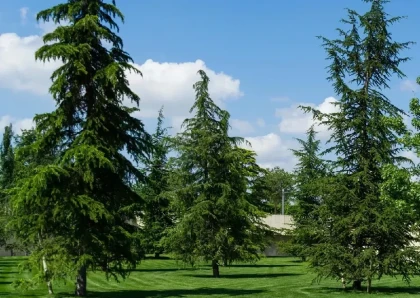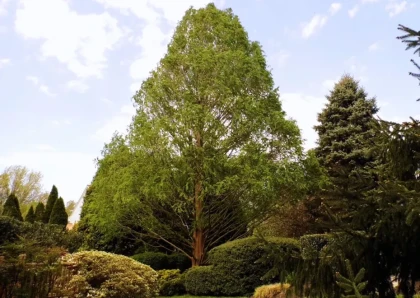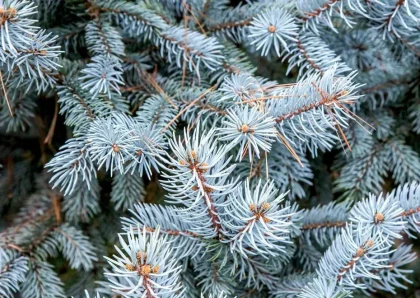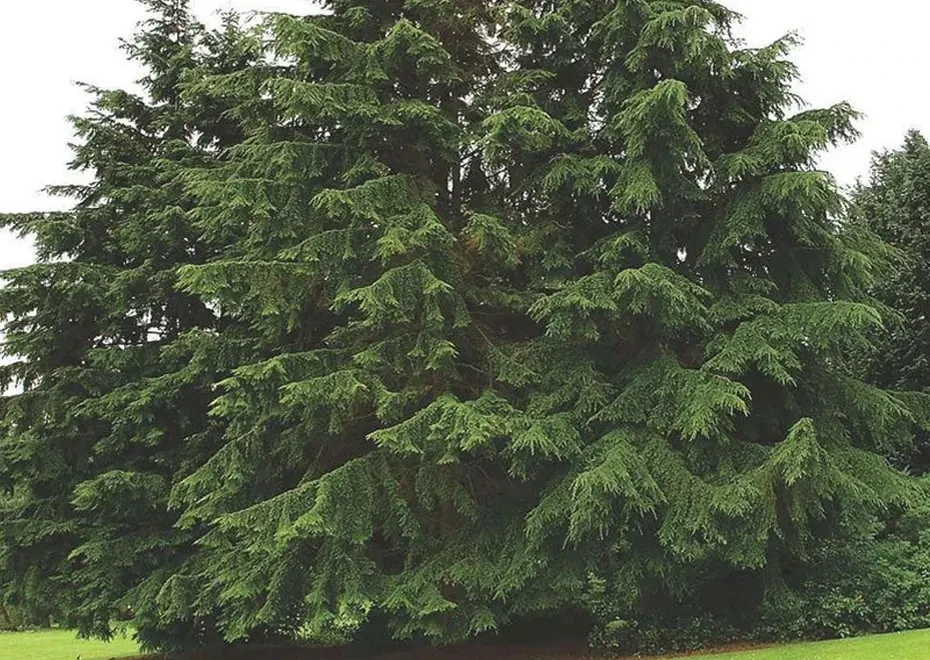
Canadian Hemlock Tree
Overview
Description
Canadian Hemlock (Tsuga canadensis) is a species of coniferous tree native to eastern North America, including Canada and parts of the United States. It belongs to the family Pinaceae and is often referred to simply as Eastern Hemlock or Hemlock.
Characteristics
- Appearance: The tree is known for its graceful and dense evergreen foliage. The needles are flat, soft, and dark green with two white lines on the underside.
- Size: Canadian Hemlocks are typically medium to large-sized trees, reaching heights of 60 to 100 feet (18 to 30 meters) or more.
- Habit: They have a conical or pyramidal shape, with a straight trunk that can be quite thick.
- Bark: The bark is reddish-brown in color and has deep furrows and ridges.
- Cones: The cones of the Canadian Hemlock are small, usually about 0.5 to 0.75 inches (1.3 to 1.9 cm) long, and have thin scales. These cones hang downward from the branches.
Habitat and Ecological Importance
Canadian Hemlocks thrive in moist, shaded environments. They are often found along stream banks and in cool, wooded areas. The trees play a crucial role in their ecosystems by providing habitat and food for various wildlife species.
Commercial Use
Historically, the wood of Canadian Hemlock was valuable for construction, especially in the past for building log cabins. Today, it is still used for lumber, although it may not be as widely used as some other coniferous species.
Popular Cultivars/Varieties of Canadian Hemlock
- Tsuga canadensis 'Canadian Dwarf': This cultivar is known for its compact size and slow growth, making it suitable for small gardens or container planting.
- Tsuga canadensis 'Cole's Prostrate': This cultivar has a prostrate growth habit, meaning it grows close to the ground and spreads horizontally, making it an excellent choice for ground cover or rock gardens.
- Tsuga canadensis 'Jeddeloh': Also known as the Dwarf Hemlock, this cultivar has a slow growth rate and a dense, compact form, making it suitable for smaller spaces.
- Tsuga canadensis 'Sargentii': This cultivar has a more pyramidal shape compared to the species, and it tends to be smaller and more dense.
- Tsuga canadensis 'Moon Frost': This cultivar has attractive, silvery-blue needles, adding a unique color element to the landscape.
- Tsuga canadensis 'Pendula': This cultivar has weeping branches, creating an elegant and graceful appearance.
Wood Products from Canadian Hemlock
Canadian Hemlock (Tsuga canadensis) wood is versatile and can be used to create various wood products due to its desirable properties. Some of the different types of wood products that can be made from Canadian Hemlock include:
- Lumber: Canadian Hemlock wood is used to produce lumber for construction purposes. It is often used in framing, interior finish work, and general carpentry. The wood's strength, stability, and ease of workability make it suitable for structural applications.
- Plywood: Hemlock plywood is made by gluing thin layers of Hemlock veneers together, resulting in a strong and durable sheet material. Plywood is commonly used for sheathing, flooring, and other applications requiring large, flat panels.
- Boards and Panels: Canadian Hemlock wood is used to manufacture boards and panels that can be used in various applications, including furniture making, cabinetry, and shelving.
- Doors and Windows: The wood's stability and attractive grain make it suitable for crafting doors and window frames.
- Moldings and Trim: Hemlock wood is used to create moldings and trim pieces, adding decorative elements to homes and buildings.
- Siding: Canadian Hemlock siding provides a natural and visually appealing exterior finish for houses and other structures.
- Furniture: The wood's light color and smooth texture make it suitable for crafting furniture pieces, especially when a more natural or rustic look is desired.
- Millwork: Hemlock is often used in millwork applications, such as staircases, handrails, and balusters.
- Panelling and Ceiling: The wood can be used for wall paneling and ceiling finishes, providing warmth and character to interior spaces.
- Wooden Containers: Hemlock wood is used to make wooden crates and containers for packaging and shipping various goods.
Benefits of Canadian Hemlock
Canadian Hemlock (Tsuga canadensis) offers several benefits, both ecologically and commercially. Here are some of the key benefits of this tree:
Ecological Importance:
- Habitat: It offers shelter and nesting sites for a variety of wildlife, including birds and mammals.
- Soil Protection: The tree's dense foliage helps protect the forest floor from erosion, maintaining soil stability and preventing nutrient runoff.
- Shade and Cooling: Hemlock forests create shaded areas, which can help regulate local temperatures and reduce heat stress for plants and animals.
- Biodiversity: Hemlock-dominated forests support diverse plant and animal communities, contributing to overall ecosystem health.
Carbon Sequestration:
Like other trees, Canadian Hemlock sequesters carbon dioxide from the atmosphere during photosynthesis, helping to mitigate the impacts of climate change by reducing greenhouse gases.
Timber and Wood Products:
The wood of Canadian Hemlock has commercial value and is used in various wood products, such as lumber, plywood, boards, and panels. It is favored for construction due to its strength, workability, and natural durability.
Landscaping and Ornamental Use:
Canadian Hemlock is popular in landscaping and ornamental horticulture due to its attractive, dense foliage and graceful form. It is often used in gardens, parks, and as a specimen tree in residential landscapes.
Privacy and Windbreaks:
Due to its dense growth, Canadian Hemlock can be used as a natural privacy screen and windbreak in residential and agricultural settings.
Shade and Aesthetics:
Hemlock trees provide shade in recreational areas and parks, offering a pleasant environment for outdoor activities during hot weather.
Wildlife Food Source:
The seeds of Canadian Hemlock are a source of food for birds and small mammals, contributing to the food web in forest ecosystems.
Natural Forest Regeneration:
Hemlock forests can support natural regeneration of other tree species due to their role in creating favorable microclimates and providing shade.
Medicinal Uses:
Historically, certain parts of the Canadian Hemlock tree were used by some Native American tribes for medicinal purposes. However, it is crucial to note that the usage of any plant for medicinal purposes should be done with proper knowledge and caution.
Tips for Planting and Maintaining Canadian Hemlock
Here are some tips to help you with planting and caring for Canadian Hemlock:
- Site Selection: Choose a location with well-draining soil and partial to full shade. Canadian Hemlocks prefer cool, moist environments and are sensitive to hot, dry conditions.
- Soil Preparation: Prepare the soil by adding organic matter such as compost or peat moss to improve soil structure and moisture retention.
- Planting Hole: Dig a hole that is slightly larger than the root ball of the Hemlock. Ensure that the top of the root ball is level with the surrounding soil.
- Planting Depth: Avoid planting the tree too deep. The root flare (where the trunk begins to widen at the base) should be at or slightly above ground level.
- Watering: After planting, water the tree thoroughly to settle the soil and help the roots establish. Keep the soil consistently moist during the first year, especially in dry periods.
- Mulching: Apply a layer of mulch around the base of the tree to retain soil moisture, suppress weeds, and maintain a more even soil temperature.
For maintenance:
- Watering: Canadian Hemlocks require regular watering, especially during dry spells. Ensure the soil remains consistently moist but not waterlogged.
- Fertilizing: Hemlocks typically do not require heavy fertilization. If the tree shows signs of nutrient deficiency, a balanced, slow-release fertilizer can be applied in the spring.
- Pruning: Minimal pruning is generally required for Hemlocks. Remove any dead, damaged, or diseased branches as needed. Avoid heavy pruning, as Hemlocks do not tolerate extensive cutting back of branches.
- Mulching: Replenish the mulch layer as needed to maintain an adequate depth (about 2-4 inches) and keep it away from the tree's trunk to prevent rot.
- Protection from Winter Winds: In colder climates, consider providing protection from strong winter winds, as Hemlocks are susceptible to winter burn.
- Pest and Disease Management: Keep an eye out for pests and diseases that can affect Hemlocks, such as the Hemlock woolly adelgid. Consult with a local arborist or horticulturist if you notice any issues.
- Winter Watering: In areas with low snowfall or during dry winters, continue to water the tree as needed to prevent winter dehydration.
Cons of Planting Canadian Hemlock
While Canadian Hemlock (Tsuga canadensis) has many benefits, there are also some potential drawbacks or cons to consider before planting it. Here are some cons of planting Canadian Hemlock:
- Susceptibility to Pests: Canadian Hemlock is vulnerable to pests, particularly the Hemlock Woolly Adelgid (Adelges tsugae). These tiny insects feed on the tree's sap, leading to needle loss, branch dieback, and even tree mortality if left untreated.
- Disease Susceptibility: Apart from pests, Hemlocks can also be susceptible to various diseases, including root rot and needle cast diseases. These conditions can weaken the tree and lead to health issues.
- Moisture Requirements: Canadian Hemlocks prefer moist, well-drained soil and are not tolerant of drought conditions. In areas with dry or arid climates, it may be challenging to provide the consistent moisture they need.
- Shade-Tolerance: While Canadian Hemlock thrives in shaded environments, excessive shade can limit its growth and may affect its overall health if planted in areas with insufficient light.
- Slow Growth: Hemlocks are known for their slow growth rate compared to other tree species. If you are looking for a rapidly growing tree, Canadian Hemlock may not be the best choice.
- Potential Size: Canadian Hemlocks can grow quite large over time, which might be a disadvantage if space is limited in your landscape or if you're looking for smaller trees.
- Invasive Potential: In certain regions, Canadian Hemlock can be considered invasive and may outcompete native plant species, disrupting the local ecosystem.
- Winter Burn: In cold climates, Hemlocks may experience winter burn, where the needles turn brown due to exposure to harsh winter conditions, particularly strong winds and low temperatures.
- Site Sensitivity: Canadian Hemlocks have specific site requirements and may not be suitable for all landscapes. Improper planting sites or soil conditions can lead to stress and reduced tree health.
- Maintenance Requirements: Canadian Hemlocks, especially when planted in residential landscapes, may require regular maintenance, including pest monitoring, disease control, and providing sufficient moisture during dry periods.
Conclusion
In conclusion, Canadian Hemlock (Tsuga canadensis) is a versatile and valuable tree species that offers numerous benefits while also presenting some considerations for planting and maintenance.
As an evergreen tree, Canadian Hemlock contributes to ecological balance by providing habitat, sequestering carbon dioxide, and supporting biodiversity in its native ecosystems. Its wood is used in various wood products and has ornamental value in landscaping.
However, there are some cons to be aware of when considering Canadian Hemlock for planting. The tree is susceptible to pests and diseases, requiring proper monitoring and care to maintain its health. Its slow growth rate and potential size may not be ideal for all landscapes, and its preference for shade and moist soil may limit its suitability in certain environments.
Despite these considerations, with proper site selection, care, and maintenance, Canadian Hemlock can thrive and offer long-term benefits in both natural and cultivated landscapes. Before planting, it is essential to assess the specific conditions and requirements of your location and consult with local experts to make informed decisions about integrating Canadian Hemlock into your landscape. Overall, when appropriately managed, Canadian Hemlock can be a beautiful and valuable addition to forests, gardens, and green spaces.
FAQs for Canadian Hemlock
1. What is Canadian Hemlock?
Canadian Hemlock (Tsuga canadensis) is an evergreen tree native to North America. It is known for its graceful appearance, soft needles, and attractive foliage.
2. What are the ideal growing conditions for Canadian Hemlock?
Canadian Hemlocks thrive in cool, moist environments with well-draining soil. They prefer partial to full shade and are not tolerant of hot, dry conditions.
3. How fast does Canadian Hemlock grow?
Canadian Hemlocks have a slow growth rate compared to many other tree species. On average, they can grow around 12 to 24 inches per year under optimal conditions.
4. Are Canadian Hemlocks susceptible to pests and diseases?
Yes, Canadian Hemlocks are susceptible to pests and diseases. One of the significant concerns is the Hemlock Woolly Adelgid, a tiny insect that can cause severe damage to the tree if left untreated. Hemlocks can also be affected by various diseases, such as root rot and needle cast diseases.
5. Can I plant Canadian Hemlock in my garden?
Yes, you can plant Canadian Hemlock in your garden if you have the appropriate growing conditions, such as shade and moist soil. Ensure that you have enough space for the tree to grow, as they can reach considerable heights over time.
6. How do I care for Canadian Hemlock?
Caring for Canadian Hemlock includes regular watering, especially during dry periods, mulching to retain soil moisture, and providing protection from harsh winter winds in colder climates. Regular monitoring for pests and diseases is also essential for maintaining tree health.
7. Can Canadian Hemlock be used for lumber?
Yes, Canadian Hemlock wood is used for lumber and various wood products, including plywood, boards, and panels. It is favored for construction due to its strength, workability, and natural durability.
8. Is Canadian Hemlock an invasive species?
No, Canadian Hemlock is not considered an invasive species. However, it is essential to ensure that you are planting it in suitable locations and not disrupting natural habitats with the introduction of non-native trees.
9. How can I prevent winter burn on Canadian Hemlock?
To prevent winter burn, you can provide protection from strong winter winds by planting Hemlocks in areas with natural windbreaks or by using burlap or other materials to shield the tree from harsh conditions.
10. Can I use Canadian Hemlock as a privacy screen?
Yes, Canadian Hemlock's dense foliage makes it suitable for use as a natural privacy screen. However, consider its slow growth rate when planning for privacy in the short term.
No listings available
Related Products
Golden Jubilee Peach Tree
Prunus persica 'Golden Jubilee' is a specific cultivar of peach tree. It is a deciduous fruit tree belonging to the Rosaceae family. 'Golden Jubilee'...
Gray Dogwood
Cornus racemosa, commonly known as the gray dogwood or northern swamp dogwood, is a deciduous shrub native to eastern North America. It belongs to...
Common Fragrant Lilac
Syringa vulgaris, commonly known as the Common Lilac or French Lilac, is a deciduous shrub belonging to the genus Syringa in the olive family...
European Beech Tree
The European Beech (Fagus sylvatica) is a deciduous tree species native to much of Europe, including parts of western Asia. It is one of...
Emerald Arborvitae Tree
The Emerald Arborvitae (Thuja occidentalis 'Smaragd') is a popular evergreen tree or shrub in landscaping and gardening. It belongs to the cypress family (Cupressaceae)...
Eastern Red Cedar Tree
The Eastern Red Cedar, scientifically known as Juniperus virginiana, is a species of evergreen tree native to eastern North America. It belongs to the...
Douglas Fir Tree
The Douglas Fir (Pseudotsuga menziesii) is an evergreen coniferous tree that belongs to the Pinaceae family. It is one of the most common and...
Deodar Cedar Tree
The name "Deodar" is derived from the Sanskrit words "deva" (meaning "god") and "daru" (meaning "wood" or "tree"), hence it is often referred to...
Dawn Redwood Tree
The Dawn Redwood tree, scientifically known as Metasequoia glyptostroboides, is a deciduous coniferous tree that belongs to the family Cupressaceae. It is a unique...
Colorado Blue Spruce Tree
The Colorado Blue Spruce, scientifically known as Picea pungens, is a species of coniferous tree belonging to the Pinaceae family. It is native to...




